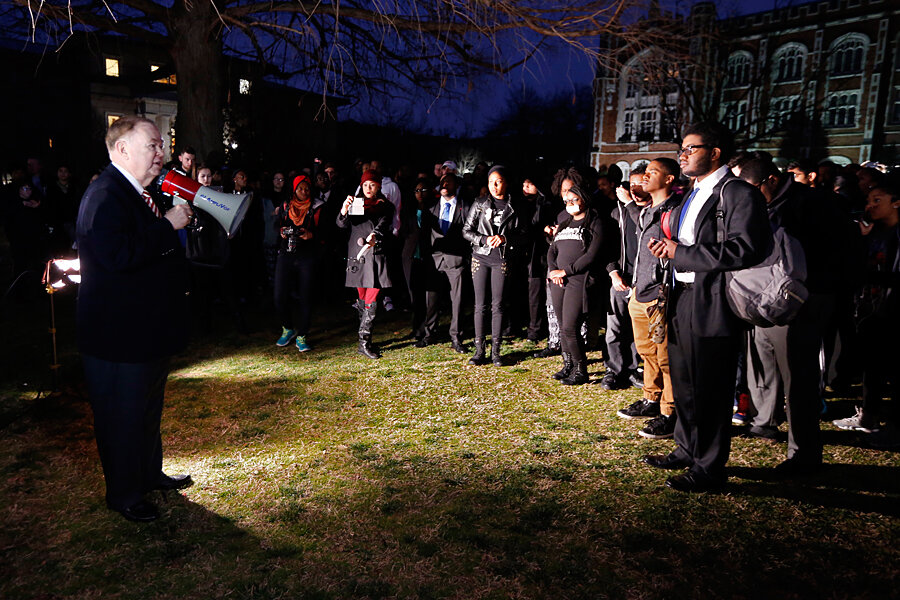Oklahoma racist frat chant: glimpse of what goes on behind closed doors
Loading...
The response to a video that surfaced Sunday, showing Sigma Alpha Epsilon fraternity members singing a racist chant on a bus, was swift. By Sunday night, SAE's national headquarters had closed its chapter at the University of Oklahoma and suspended all those members, and the university severed "all ties and affiliations" between the school and fraternity.
University President David Boren also appeared at a rally Monday morning and issued a statement calling the students "disgraceful" and directing members to vacate the closed SAE house by midnight Tuesday.
But plenty of people on social media have stepped forward to say that, as ugly as the chant is, it's hardly surprising and that they know of similar events that simply didn't happen to be caught on video. Matthew Hughey, a University of Connecticut sociologist who has studied the Greek system, says that the video is simply a very visible sign of how the system is fraught with inequality and racism.
"I’d like to say from a moral standpoint that it’s abhorrent, or somehow unique, but research points to [indications] that the white fraternity system is based on class and racial seclusion, and the discourse within those walls is quite often classist and racist," Professor Hughey says. "So that’s what was caught on camera and what we’re witnessing."
In the video, students are shown on a bus saying a chant that includes the N-word. "You can hang him from a tree, but he can never sign with me," goes another part of the chant.
“I was an SAE at a university in Texas from 2000-2004. The exact same chant was often used then. This is not isolated," one Twitter user wrote Sunday, according to The Washington Post.
SAE was quick to condemn the incident, saying in a statement that those responsible for it may have their memberships revoked permanently and that "this type of racist behavior will not be tolerated and is not consistent with the values and morals of our fraternity."
However, the fraternity, which was founded at the University of Alabama in Tuscaloosa in 1856, has had numerous incidents in recent years involving hazing as well as racist and sexist behavior. Bradley Cohen, SAE's national president, wrote in a message to members on its website that "the media has labeled us as the 'nation's deadliest fraternity,' " and he noted that SAE was dropped by its previous insurer and is now paying the highest rates of any fraternity. It has had to close 12 chapters in the past 18 months because of hazing-related incidents.
In the past few decades, it has had chapters fined or suspended for incidents like throwing a "jungle party" with brothers in blackface and having white pledges recite rap lyrics with the N-word to black students.
The University of Oklahoma video surfaced when it was sent anonymously to Unheard, a campus organization that was founded in response to the Michael Brown shooting in Ferguson, Mo. Unheard posted the video on Twitter, adding Mr. Boren's Twitter handle to it, and he quickly responded.
At the rally Monday morning, many students appeared with duct tape over their mouths or carried signs asking, "Can you hear me now?" Social media lit up with condemnations of the fraternity members and pride in the community's swift response.
The fraternity house was reportedly vandalized with spray paint Sunday night, and hip-hop artist Waka Flocka Flame announced he would be canceling his scheduled show at the university next month.
But such condemnation is relatively easy, says Hughey, and doesn't do much to address the systemic causes of this sort of racism.
"Universities and colleges have become very savvy about what’s politically correct," he says. "They're quick to demonize overt racism like this, but they're pretty silent about the everyday aspects of racial inequalities that are just as much racism in intent and effect."
Fraternities and sororities have a long tradition of exclusion, says Nicholas Syrett, author of “The Company He Keeps: A History of White College Fraternities” and a historian at the University of Northern Colorado in Greeley. All the white fraternities at one time had clauses saying they would never admit people of color, he notes – the main reason that minority-focused fraternities were founded.
While the civil rights movement caused those clauses to be dropped, the degree to which traditionally white fraternities have admitted racial and religious minorities has varied a lot by both group and geography, Professor Syrett says.
“Some fraternities, and some colleges, have very self-consciously tried to integrate and have done a pretty good job of it, but there are definitely holdouts, especially in some Southern schools,” he says. There are little data about current racial demographics in fraternities, he adds: “The fraternities don’t want to talk about it openly.”
Social media and the proliferation of cellphone video technology have made it easier for incidents like this SAE one to be publicized, but they may not be helping to eradicate the racism so much as drive it underground. Many fraternities now ban cellphones at their events, Hughey says. Subsidized housing, campus prestige, and post-college networking opportunities all contribute to what he calls "an incredibly unequal self-perpetuating system."
"When you have these spaces that are not only subsidized, but almost treated as no-fly zones by the university ... you allow for a great deal of power to accumulate, and it gets reproduced along race, gender, and class lines," he says. "It's a manifestation of our larger problem as a nation, with our inability to talk realistically about race."






